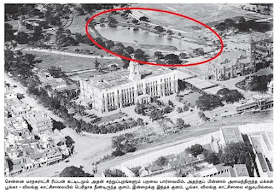Who is responsible for Chennai reeling under floods, Wherever we live today, there was once a dense forest. This applies to many cities. However, under many parts of Chennai that stand up today, there is no trace of a water body lying deep in slumber. Anyone who looks through the history of Chennai will realize this.
There is no trace of water bodies in Chennai
It is against this backdrop that environmentalists and the general public have started fighting to protect Borur Lake, one of Chennai’s remaining major water sources.

History of water
Chennai and water famine are like twins born together. Until the middle of the 19th century, the water required for the city of Chennai was taken from wells and lakes-water bodies. But in the 1940s, Chennai’s water needs remained unmet and complex. After the independence of the country, water from Bundi, Sengunram and Cholavaram reservoirs was used to meet the demand.

When that was not enough, the then Chief Minister Anna announced the plan to bring water from Veeranam Lake in 1967. Even with all these factors in hand, Chennai’s water demand in 1974-75 was insurmountable. It was only then that bore wells and water trucks to draw ground water were established. In the 1990s, when water began to move beyond the reach of ordinary people, private companies began pumping water from the suburbs, trucking it in and selling it. When the reservoirs dried up in 2003-04, the water shortage in Chennai became acute again.
Collapsed space

In this way, the water that was available in the adjacent aquifer gradually shifted to piped supply and finally turned upside down to being distributed by trucks. Today, the price paid for water is high, and the price the natural environment pays for water is incalculable. If we look back at the history of water shortage in Chennai, first there was an interval of 80 years, then an interval of 35 years, and then an interval of 15 years. If we look at this and climate change, we can realize that Chennai’s water shortage is not natural.
Lost maintenance
Our forefathers who lived in Chennai-old Chengalpattu district where there was no permanent water source like river, realized the need of water and acted accordingly. There is historical evidence that irrigation lakes, both naturally formed and excavated out of necessity, have been maintained over time. This continuity can be seen as far back as a hundred years ago.

After that, concern about water bodies started to decrease little by little. When ‘urban development’ became a priority after the country’s independence, water bodies were the first to be captured. The pictures featured here are proof of that. The Ripon Building, which houses the Chennai Corporation, was built in 1913. In the bird’s eye view picture, there are 11 ponds in the People’s Park – Corporation Animal Showroom area located behind it. One could not help but wonder when one saw the pool stretching out into them. Today it is not.
The Lost Horseshoe Lake
Today we can see roads and projects like Lakeside Road, Canalside Road, Mukappher Lake Housing Project, Mambalam Lake Housing Project in various parts of Chennai. All these areas were once lakes and canals. Today only the names remain, the lakes have disappeared.
The first of these lakes to disappear is Chennai’s huge lake known as ‘Long Tank’ in English. This lake stretched in the shape of a horseshoe from Chetupatta, Nungampakkam, Thenampettai and Saidappettai. Nungambakkam Lake, Mambalam Lake and Mylapore Lake were called by different names according to the location.
The lake is on the 1909 gazette map. Today Chulaimedu, Loyola College, Valluvar Kottam are situated in the area where Nungampakkam lake was. Similarly, West Mambalam, Pandi Bazaar, Panagal Park, a part of Kodambakkam are located in the area where Mambalam Lake was. It is said that the Thenampet Alaiyamman temple is the boundary of this horse lake. Today there is no trace of that long lake. If the lakes are destroyed without even a trace like this, how can we get only water later?
Ruined Pallikaranai Lake
If the destruction of the above water bodies predates our time, the destruction of Pallikaranai Mangrove in South Chennai is happening right before our eyes. Research suggests that in the 1960s the Pallikaranai mangrove stretched over 5000 hectares in central Kailash where Rajiv Gandhi Road begins. During the next 40 years the Pallikarana Mangrove was plundered in various ways. Only a tenth of that remains today.

Over this mangrove area of nearly 80 hectares, the Corporation there is littering, Bags have been dumped. In the 2012 satellite image, the mangrove watershed is visible in green. The brown area circled in the middle is where the garbage was dumped.
Not only that, various buildings like Velachery Flying Railway Station, Central Government Institutions, Bridges are located in different parts of the mangrove. Real estate is also not without a look at Palikarana.
Will the remnant be saved?



![]()

